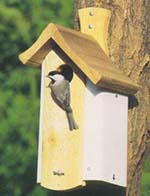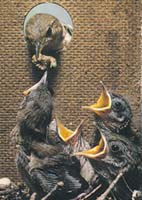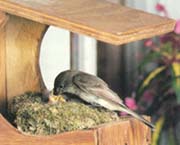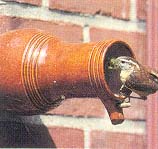Homes for Birds
Birds You Can Attract to Nest Boxes
Many of the birds that visit feeders and baths may stay and nest in nearby trees. Most of them, including cardinals, doves and orioles, don’t nest in boxes. You can still help them by considering their food and shelter requirements in your landscape plans.
More than two dozen North American birds nest in birdhouses. The following descriptions will help you determine which birds might visit your neighborhood.
Bluebirds
If you put up a bluebird house near an old field, orchard, park, cemetery or golf course, you might have a chance of attracting a pair of bluebirds. They prefer nest boxes on a tree stump or wooden fence post between three and five feet high. Bluebirds also nest in abandoned woodpecker nest holes.
The most important measurement is the hole diameter. An inch and a half are small enough to deter starlings, which, along with house sparrows, have been known to kill bluebirds, as well as adults sitting on the nest. Bluebirds have problems with other animals too. Discourage cats, snakes, raccoons, and chipmunks by mounting the house on a metal pole, or use a metal predator guard on a wood post.
American Robins
The robin is our largest thrush. They prefer to build their nest in the crotch of a tree. If you don’t have an appropriate tree, you can offer a nesting platform. Pick a spot six feet or higher up on a shaded tree trunk or under the overhang of a shed or porch. Creating a “mud puddle” nearby offers further enticement, as robins use mud to hold their nests together.
Chickadees, Nuthatches, and Titmice
Chickadees, titmice, and nuthatches share the same food, feeders, and habitat. If you put a properly designed nest box in a wooded yard, at least one of these species might check it out. Put chickadee houses at eye level. Hang them from limbs or secure them to tree trunks. The entrance hole should be 1 1/8 inches to attract chickadees, yet exclude house sparrows. Anchor houses for nuthatches on tree trunks five to six feet off the ground.

Brown Creepers and Prothonotary Warblers
Look for brown creepers to nest behind the curved bark of tree trunks. In heavily wooded yards, slab bark houses appeal to creepers. Prothonotary warblers also prefer slab bark houses or bluebird boxes attached to a tree trunk, but theirs must be placed over water (lakes, rivers or swamps) with a good canopy of trees overhead.
Wrens
Wrens don’t seem to be very picky about where they nest. Try nest boxes with a 1-inch x 2-inch horizontal slot (1½ inch x 2 ½ inch for the larger Carolina wrens) instead of a circle. These are easier for the wrens to use. However, the larger the opening, the more likely it is house sparrows will occupy the box.
 Wrens are known for filling a nest cavity with twigs, regardless of whether they use the nest to raise their young. Since male house wrens build several nests for the female to choose from, hang several nest boxes at eye level on partly sunlit tree limbs. Wrens are sociable and will accept nest boxes quite close to your house.
Wrens are known for filling a nest cavity with twigs, regardless of whether they use the nest to raise their young. Since male house wrens build several nests for the female to choose from, hang several nest boxes at eye level on partly sunlit tree limbs. Wrens are sociable and will accept nest boxes quite close to your house.
Tree and Violet-green Swallows
Tree swallows prefer nest boxes attached to dead trees. Space the boxes about seven feet apart for these white-bellied birds with iridescent blue-green backs and wings. The ideal setting for these insect-eaters is on the edge of a large field near a lake, pond or river.
Violet-green swallows nest in forested mountains of the West; boxes placed on large trees in a semi-open woodland will attract them.
Barn Swallows and Phoebes

If you have the right habitat, like an open barn or old shed, barn swallows and phoebes are easy to attract. It’s their nesting behavior, not their plumage or song, that catches your attention. However, these birds tend to nest where you would rather not have them: on a ledge right over your front door. To avoid a mess by your door, offer the birds a nesting shelf nearby where you’d rather have them.
Purple Martins
Many people want martins in their yards because it’s been said, these birds eat 2,000 mosquitoes a day. While it’s true that they eat flying insects, don’t expect purple martins to eliminate mosquitoes in your yard completely Martins prefer dragonflies, which prey on mosquito larvae. If you want to help rid your yard of mosquitoes, put up a bat roosting box. One bat can eat thousands of mosquitoes a night.
Martins are entertaining creatures, however, and you’ll enjoy watching their antics in your backyard. You have the best chance of attracting martins if you put a house on the edge of a pond or river, surrounded by a field or lawn. Martins need a radius of about 40 feet of unobstructed flying space around their houses. A telephone wire nearby gives them a place to perch in sociable groups.
Martins nest in groups, so you’ll need a house with a minimum of four large rooms-6 or more inches on all sides, with a 2 1/2 inch entrance hole about 1 1/2 inches above the floor. Ventilation and drainage are critical factors in martin house design. Porches, railings, porch dividers and supplemental roof perches, like a TV antenna, make any house more appealing.
You can also make houses from gourds by fashioning an entrance hole and small holes in the bottom for drainage. If you use gourds, it’s not necessary to add railings and perches. Adult martins will perch on the wire used to hang the houses. Before you select a house, think about what kind of pole you’re going to put it on. Martins occupy a house ten to twenty feet off the ground. Some poles are less cumbersome than others.
Other Links:
- For the birds
- Back yard bird feeding
- Bird Feeder Selection
- How Many Birds
- Birds Attracted by Various Feeders and Foods
- Uninvited Guests at the Birdfeeder
- Questions about Feeding Wild Birds
- Homes for Birds
- Selecting a Bird House
- Bird House Design
- Bird Nest Box Dimensions
- Bird House Placement
- Protection from Predators
- Attracting Birds
- Landscaping for Birds
- Basics of Landscaping for Birds
- Plants for Wild Birds
- How to Get Started
- Protecting Bird Habitat
- Additional Readings
